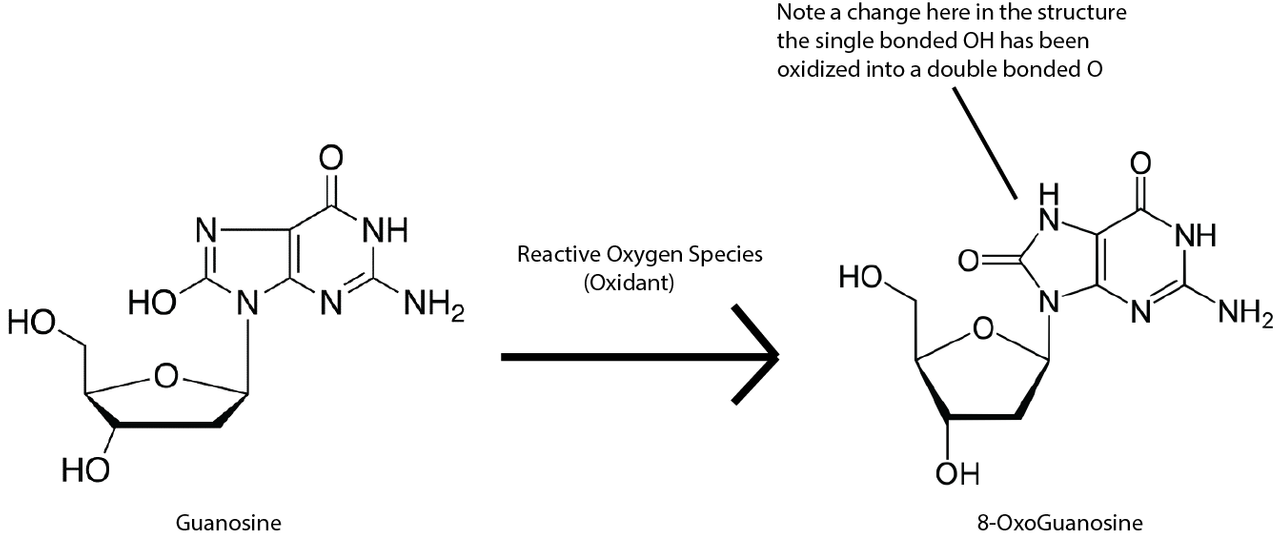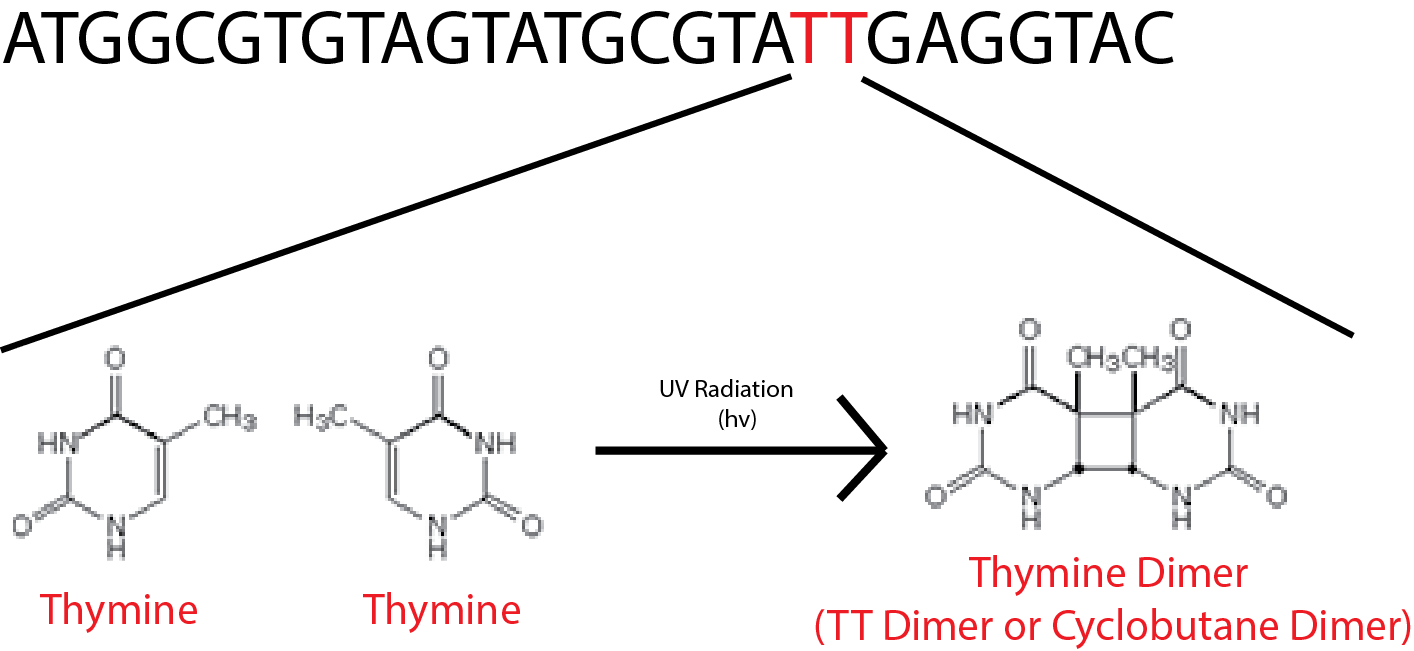Preface
In previous posts we have discussed:
Part 1: The Basics of DNA
Here we discussed a bit about what DNA is, the molecule itself and an overview of what its use is in the cell.
Part 2: DNA Replication
Here we went into a bit more detail about the protein mechanisms by which a new copy of DNA gets created
Part 3: Protein Expression
Here we took things a step further and went into some of the details about how information is extracted from DNA and is turned into the functional component of the cell known as a protein.

Source: https://yalebiodebate.files.wordpress.com
Today we will take on the topic of DNA damage. I am sure many of you have heard about the health benefits of "anti oxidants." We all also hear the warnings about how exposure to the sun may give you skin cancer. What you may not know is both of these statements are related by a single topic, and that is DNA damage. So let's begin!
What is DNA Damage?
In part 1 we discussed the four bases of DNA: Adenine (A) Cytosine (C) Thymine (T) and Guanosine (G). We know that these bases form pairs, A with T and C with G. DNA damage refers to any event that causes a change in the structure of a single base, or causes a break in the backbone (how the bases are linked together) either resulting in the break of a single strand, or the complete severing of the double strand. Lets discuss some types of damage.
Oxidative Damage
This type of damage is prevalent due to radical oxygen species that are either generated during normal metabolic processes, or consumed externally. These species are what "anti-oxidants" that you consume (eg. Vitamin C, Vitamin E or various flavenoid molecules from green tea) help you deal with. Oxidative damage can lead to results such as changing a Guanosine base into 8-OxoGuanosine (Figure 1).
Figure 1: Oxidation of Guanosine

Source: Self
I said earlier that G binds with C right? Well 8-OxoG can bind with either C or A. So during DNA replication the DNA polymerase (Discussed in Part 2) is happily moving along, matching up bases with their binding partners as it builds a new strand of DNA. It encounters a freshly oxidized G (now 8-OxoG) and puts an A there in its place. DNA is sort of like the block chain, and the polymerase moving past and creating the strand is much like a confirmation. Once the DNA has been "confirmed" that A is forever recorded. All subsequent replication events will put an A or its pair T in that location where a G was prior to the damage. This has big implications for the cell (and for you), if you recall from Part 3 where we talked about how proteins are assembled by reading the DNA sequence in those triplicate codons. Well say we changed a codon with the incorporation of that A and we went from GAA to AAA, that means that when a cell makes a protein that instead of putting the amino acid alanine, it puts an entirely different one, threonine. This can lead to disastrous effects on how that protein functions and may lead to the cell in which the change happened becoming cancerous.
Radiative Damage
Radiative damage or damage induced by radiation such as ultra violet light from the sun, is another type of DNA damage. Radiation can have a variety of effects on DNA ranging from inducing single strand breaks by cleaving the backbone (this type of damage is easily repaired by an enzyme called DNA ligase, and is not an issue). It can cause a double strand break where the whole DNA double helix is chopped into two pieces (more difficult to repair, and the process itself induces other errors). However the type of damage I will show you is called a T-T Dimer. Ultraviolet light, rather than changing just one base in the DNA it actually effects two T's in a row (Figure 2), linking them together.
Figure 2: Thymine Dimerization

Source: Self/chemistry.msu.edu
The effect of this linking is an actual change to the shape of the DNA helix itself, it causes a distortion, a kink of sorts. This kinking of the DNA causes a DNA polymerase to pause here during replication, aka the polymerase just gets stuck. In order to get through different enzymes are recruited, but as in other cases, they too can lead to different errors (though those errors are better than the polymerase being stuck and replication grinding to a halt!)
Summing it Up
There are a variety of DNA damaging agents, and a plethora of different mutations which can arise from them. Oxidizing agents can change bases, radiative damage sources can break your DNA or fuse bases together, just to name a few! These mutations cause significant downstream issues for the cell if left un-repaired. Lucky for us there are several repair mechanisms the cell has cooked up to deal with these damages, though some are not as perfect as one might hope. In the next article I will discuss these repair mechanisms and the problems that they then create (there is always a trade off!)
What can you do to help your body fight? Eat healthy (as healthy as you can) get the vitamins that your body needs, many of these are antioxidant molecules, and they help battle the radical oxygen species which seek to damage your DNA! Wear sun-screen (and don't use tanning beds), UV radiation is actually quite harmful (worse than most people realize) getting that sexy tan is awesome, but getting cancer isn't. Protect your self and your DNA from the harmful part of the suns rays. Limit your smoking (tobacco especially), there are several molecules in tobacco smoke which will react directly with DNA, lots of oxidative damage!
That said, I'm not telling anyone how to live their lives! Certainly its not easy to live a full and happy life and not indulge in some of the finer things! There is something to be said for a bit of moderation though, as many of the finer things can have such un-fine effects on your DNA.
Upcoming Topics
How are these DNA mutations fixed?
What is Cancer and what are some causes?
Genetic Modifications (eg. How are GMO Foods Made?)
Other Topics of Interest Suggested By YOU
Editing: Fixing some grammar and spelling
